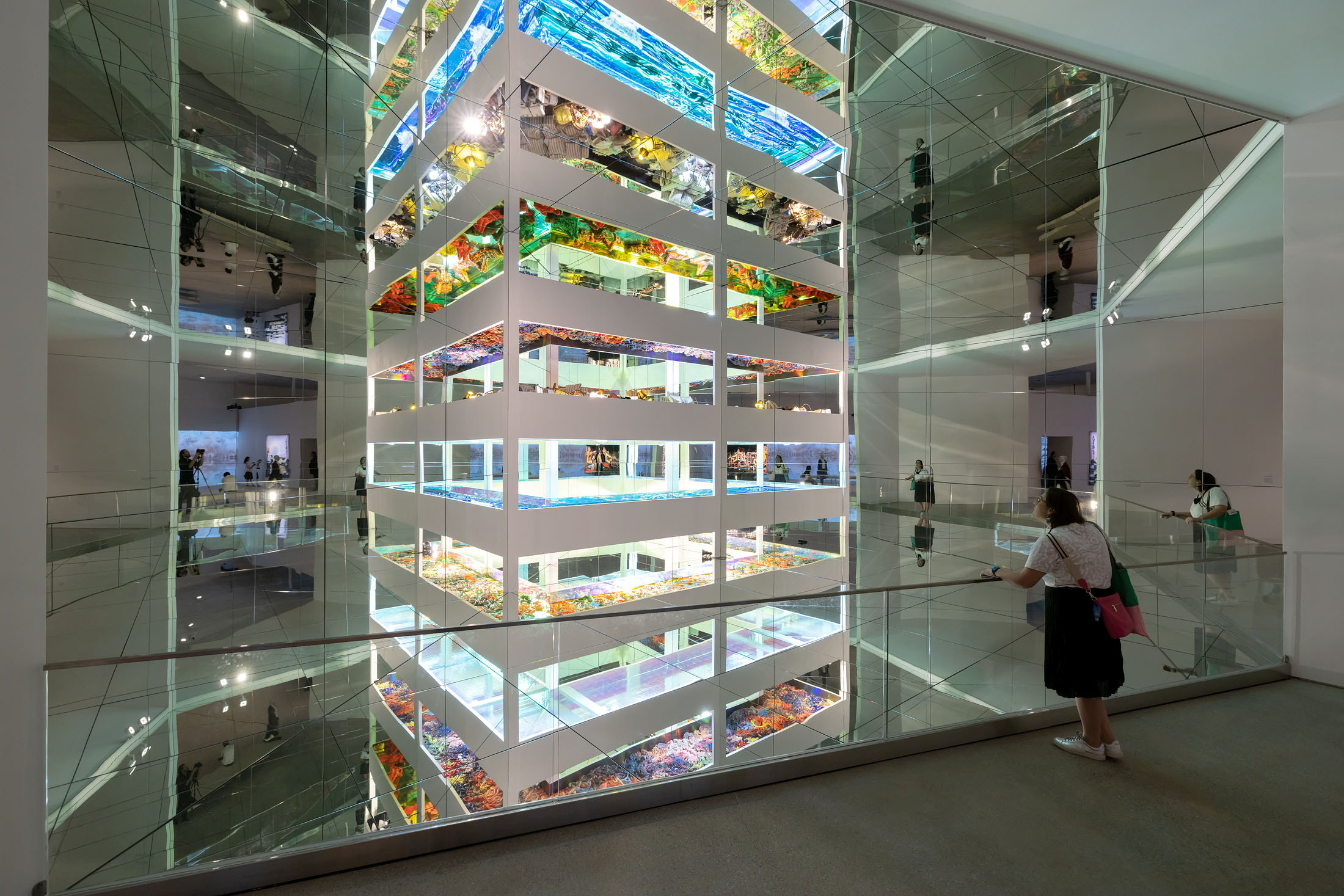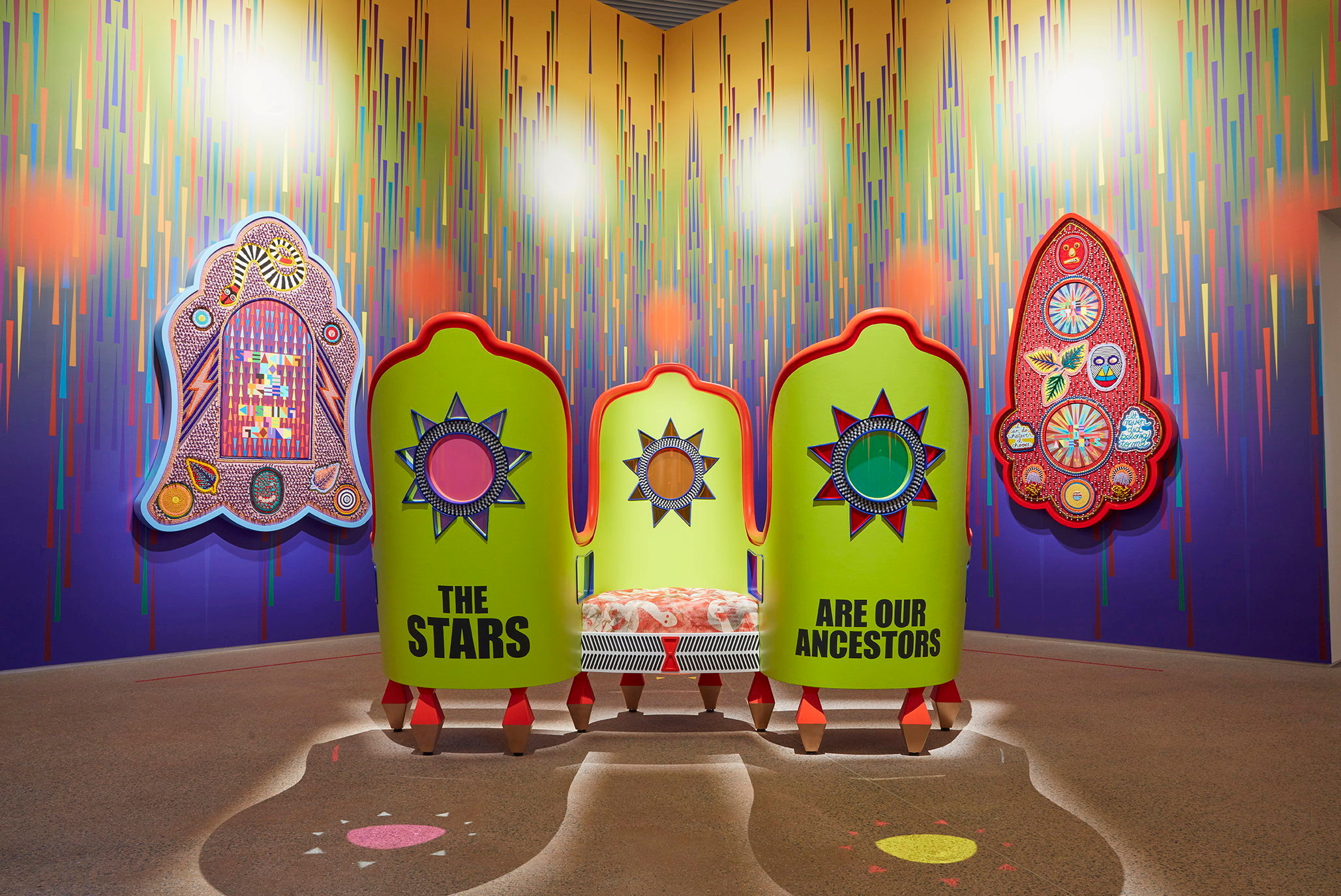Dreamhome: Stories of Art and Shelter
Neha Kale
Her eyes are closed. She leans over the table. She listens to her lover play his harmonica. Rapture remakes her features, a labour of quiet intent. On her plate, an untouched lobster. On his, a carcass. Three empty cans of Budweiser. The sum of her efforts reversed in a few stray gestures, the one-sided calculus of heterosexual relationships. Two people share one table. But their realities diverge.
Windows, doors, tables. The elements of a house offer easy metaphors for connection. They bridge the inside and outside. They bring loved ones together. But Carrie Mae Weems’s legendary Kitchen Table Series, from the 1990s, is a lesson in domestic discord. The woman and her partner remain sealed in their private bubbles of experience, even as they come together over the dinner she’s lovingly prepared.
Untitled (Playing Harmonica) (1990) unfolds against a wall in Dreamhome: Stories of Art and Shelter. This exhibition—timed to coincide with the opening of Sydney Modern, the Art Gallery of New South Wales’s new $344 million expansion—features twenty-nine international and local artists whose work speaks of “home.” It’s an age-old signifier that’s become more fraught, more loaded, as crises—political, ecological, economic—splinter our sense of psychological safety. What “story” is - Weems telling? One in which home is contingent on compromise? Or—like the woman in Weems’s photograph who reserves her attention for her partner at the expense of her own sustenance—whatever stream of tiny indignities you are willing to endure?
For weeks, pavements around my neighbourhood have been cramped with anxious, would-be renters, the consequence of Sydney’s 0.8 percent vacancy rate. International students pitch tents in living rooms. Still, headlines bray about real estate, the city’s lingua franca. Sydney Modern itself overlooks the Domain, inaugurated in 1816 by Lachlan Macquarie, who dispensed some of the colony’s most significant land grants.
Descending the escalators towards Dreamhome, I register sparkling glimpses of Sydney Harbour. In a 2018 Sydney Review of Books essay, the writer Ross Gibson, who passed away this March, described the compromises that are central to the lives of those who choose to make a home here. He described the city’s beauty as an anaesthetic “that keeps citizens placid and in place.”
In Sydney, the idea of home is freighted with colonial history, splintered by growing inequality. But Sydney Modern—minus the imposing walls and sandstone façades that are a hallmark of this part of the city—strives to be a home for everyone, a truly inclusive and democratic space.

Dreamhome is an elegant and erudite exhibition. The show is divided into eight numbered “chapters”. This approach, which borrows from literature as much as from art, traces the viewer’s changing relationship to the idea of home. It invites us to read the exhibition like a book. To consider how we are made and unmade by our connections to the spaces that form us. Across from Untitled (Playing Harmonica), in a room titled Provisional Sanctuaries, a wall is given over to Tracy Moffatt’s 2017 tableaux, The Body Remembers. The series of sepia photographs calls up the life of the artist’s great-grandmother Maggie, who, like generations of Indigenous women, served as a domestic servant on a station in rural Queensland.
In one image, the artist, dressed in the monochrome of a Victorian chambermaid, sobs into her palms. We see her backwards, through a window, as if we’ve caught an accidental rupture in the lie of colonial propriety. In another, the artist’s shadow flits across the earth. Her body the collateral of this rural idyll.
The dream home, this exhibition reminds us, is a fantasy. A stage show. There are different players. One person’s comfort and security hinges on another’s sacrifice.
But the curatorial premise isn’t afraid to complicate this narrative. Nearby, Simone Leigh’s Sentinel (2019)—the first work by the acclaimed American artist to enter an Australian collection—is stony and impassive. The sculpture synthesises the visual language of African diasporas: raffia costumes, Central African meeting halls, the skirts worn by Josephine Baker. But its curves are cold, unyielding. It lacks eyes. It’s a figure that doubles as its own refuge, one that has evolved to refuse our desiring gaze.
On a plinth beside it is Louise Bourgeois’s Untitled (No 7) (1993) from The Welcoming Hands series. One pair of hands reaches for another, fingers furled together in a gesture that’s impossibly poignant. In the creases of knuckles and tendons and nails, we sense a deep yearning. But this impression of flesh is made from bronze, vulnerability and care recast as fortitude and strength.
The work is a tribute to the artist’s relationship with Jerry Gorovoy, her young, male studio assistant. Here, the artist isn’t a lone genius, a trope, as the writer Deborah Levy would put it, that’s the result of a male consciousness. On one arm, a strange growth in the shape of a house. Kin, the work suggests, appears in shapes you can’t imagine. Home can arise in the last places you choose to look.
There’s a famous Bourgeois quote, “memory is itself a form of architecture.” I sat thinking of this, transfixed, in front of Lineament, a 2012 video work by the London-based Japanese artist Hiraki Sawa. The artist owes the work to his friend, who woke up from a nap with no recollection of the life he had lived before. He moves through the rooms of his past like a ghost. The camera lingers on a window’s spiderweb cracks. The abyss of a drain. Once, he collected records and here, they unspool, unravel, untethering him to his former self.
Migrants, refugees and colonists, of course, have always known that home involves both erasure and self-creation. National identity prescribes a collective forgetting. To belong—that fuzzy sentiment!—is to assimilate. Exclude. Anoint model minorities and ideal citizens.
Across from Lineament, Hoda Afshar’s 2018 Remain series is as arresting as ever. In the darkened space, titled Shadow Homes, photographs of Behrouz Boochani, Ari Sirwan and Emad Moradi emit an unearthly glow. The people in the photos are absent but present. The contours of their bodies sketch out some unseen dimension in our imaginary, like they’ve been summoned up from our subconscious. Beside it, Untitled (2007), an unremarkable wooden cupboard. The work, conceived by Colombian artist Doris Salcedo, is a monument to those killed over three decades of drug violence. It is filled with concrete. A blank and heavy material where clothes should be.
Home, of course, is a story. We read it, first, in childhood. We return to it as adults. The works in Dreamhome are complex. They demand rereading. But to me, the show’s form, divided into numbered chapters that move forward in time assume a narrative linearity. There are metaphors. Recurring themes. We are the show’s protagonist, following a thread that reveals itself like a plot.
In the next chapter, titled House in a storm, homes are threatened, uprooted, under siege. Sayre Gomez’s electric Friday night (2021), an RV (framed by a purple LA sky, cracked with lightning) inches through an atmosphere shaped by the California wildfires and the Capitol riots. Samara Golden’s dizzying Guts (2022), a new acquisition for Sydney Modern, imagines the rotting core of late capitalism as snakelike intestines, junkyards of furniture.

The final chapter turns to our place in the cosmos. Cherokee and Chocktaw artist Jeffrey Gibson’s The stars are Our Ancestors, remakes the staid Victorian sitting room with the addition of beaded “whimsies” or souvenirs sold by Native artists in the nineteenth century. It is a joyful and exuberant retelling. There’s even a queer kissing chair! Gibson, who is shaped by the ’90s club scene, creates a space that defies histories of trauma and displacement. A parallel home where the past should be.

I want to believe in the show’s trajectory. In Jeffrey Gibson’s vision. But for me spatial memories don’t move in one direction. They run backwards and forwards. They blur, reel us back, compel an obsessive retracing.
Before I leave Dreamhome, I return to Letters from Home, a set of woodcut prints by Zarina in which the Indian-American artist writes letters to her sister Rani in Urdu. The siblings were separated by Partition. But in the artist’s mind, the courtyard home they shared as children in Aligargh, New Delhi, could never supplant those homes she’s built for herself. For the artist, home isn’t a place. It resides in the act of making and writing and teaching. It’s both gesture and bridge.
Across the room, I’m beguiled by the work of James Castle. The artist, who grew up in a farmhouse in Idaho, was born deaf. His drawings, which mix soot and his own saliva, intertwine his interior and exterior landscapes.
Castle’s childhood home is literally an extension of his own body. His scenes of floorboards and doors and shelves, barely the size of a postcard, bristle with psychological intensity. Castle’s works were discovered accidentally by builders, squirreled into a wall, while restoring his family farmhouse. I think about his drawings as I return to the escalators and leave the show, about how deeply his lines bored into scraps of paper. About how the places we come from reveal the epic in the ordinary, the map of our own making. And about what it means to find your truest home in the world.
Neha Kale is a writer and critic who lives and works on unceded Gadigal land. Her writing on art, contemporary culture and society appears in many national and international publications. She is the former editor of VAULT magazine.


